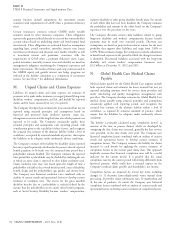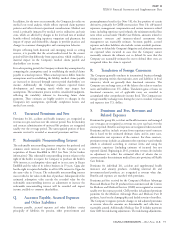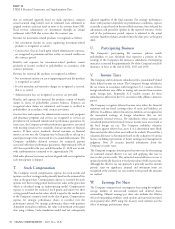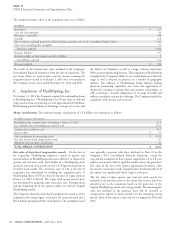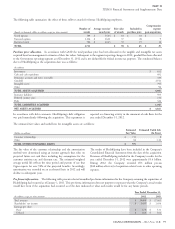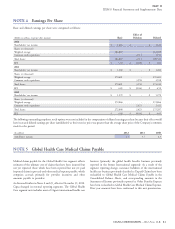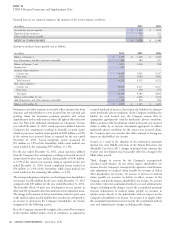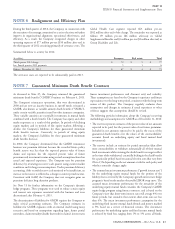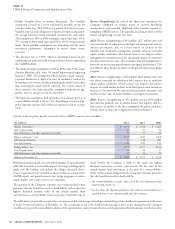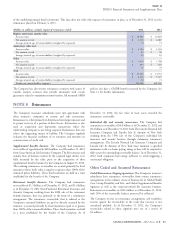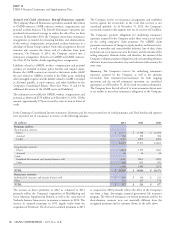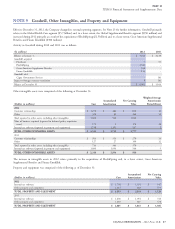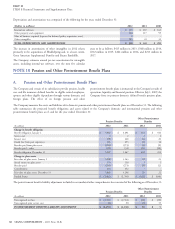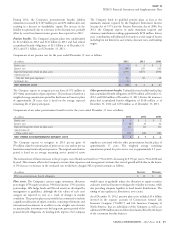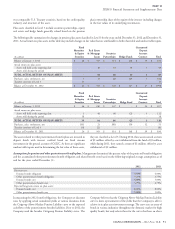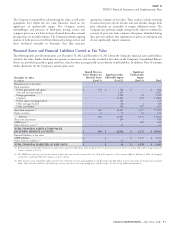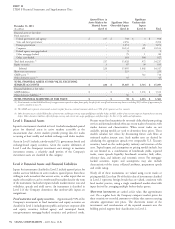Cigna 2012 Annual Report Download - page 106
Download and view the complete annual report
Please find page 106 of the 2012 Cigna annual report below. You can navigate through the pages in the report by either clicking on the pages listed below, or by using the keyword search tool below to find specific information within the annual report.
PART II
ITEM 8 Financial Statements and Supplementary Data
Market volatility refers to market fluctuation. The volatility Reserve Strengthening: In each of the three years presented, the
assumption is based on a review of historical monthly returns for Company completed its normal review of reserves (including
each key index (e.g. S&P 500) over a period of at least ten years. assumptions), and recorded additional other benefits expense to
Volatility represents the dispersion of historical returns compared to strengthen GMDB reserves. The amounts and primary drivers of the
the average historical return (standard deviation) for each index. reserve strengthening in each year were:
The assumption is 18% to 24%, varying by equity fund type; 5% to 2012: Reserve strengthening of $43 million ($27 million after-tax)
7%, varying by bond fund type; and 0% to 1% for money market was primarily due to reductions to the lapse rate assumptions, adverse
funds. These volatility assumptions are used along with the mean interest rate impacts, and, to a lesser extent, an increase in the
investment performance assumption to project future return volatility and correlation assumptions, partially offset by favorable
scenarios. equity market conditions. The adverse interest rate impacts reflect
The discount rate is 5.75%, which is determined based on the management’s consideration of the anticipated impact of continued
underlying and projected yield of the portfolio of assets supporting low short-term interest rates. This evaluation also led management to
the GMDB liability. lower the mean investment performance for equity funds from 4.75%
to 4.00% for those funds not subject to the growth interest rate hedge
The claim mortality assumption is 65% to 89% of the 1994 Group program.
Annuity Mortality table, with 1% annual improvement beginning
January 1, 2000. The assumption reflects that for certain contracts, 2011: Reserve strengthening of $70 million ($45 million after-tax)
a spousal beneficiary is allowed to elect to continue a contract by was driven primarily by volatility-related impacts due to turbulent
becoming its new owner, thereby postponing the death claim rather equity market conditions, adverse interest rate impacts, and adverse
than receiving the death benefit currently. For certain issuers of impacts of overall market declines in the third quarter that include an
these contracts, the claim mortality assumption depends on age, increase in the provision for expected future partial surrenders and
gender, and net amount at risk for the policy. declines in the value of contractholders’ non-equity investments.
The lapse rate assumption (full surrender of an annuity prior to a 2010: Reserve strengthening of $52 million pre-tax ($34 million
contractholder’s death) is 0% to 11%, depending on contract type, after-tax) was primarily due to adverse interest rate impacts, and to a
policy duration and the ratio of the net amount at risk to account lesser extent, an update to the lapse assumption for policies that have
value. already taken or may take a significant partial withdrawal.
Activity in future policy benefit reserves for these GMDB contracts was as follows:
(In millions) 2012 2011 2010
Balance at January 1, $ 1,170 $ 1,138 $ 1,285
Add: Unpaid claims 40 37 36
Less: Reinsurance and other amounts recoverable 53 51 53
Balance at January 1, net 1,157 1,124 1,268
Add: Incurred benefits 17 138 (20)
Less: Paid benefits 102 105 124
Ending balance, net 1,072 1,157 1,124
Less: Unpaid claims 24 40 37
Add: Reinsurance and other amounts recoverable 42 53 51
Balance at December 31, $ 1,090 $ 1,170 $ 1,138
Benefits paid and incurred are net of ceded amounts. Incurred benefits death benefit, the Company is liable to the extent the highest
reflect the favorable or unfavorable impact of a rising or falling equity historical anniversary account value exceeds the fair value of the
market on the liability, and include the charges discussed above. related mutual fund investments at the time of a contractholder’s
Losses or gains have been recorded in other revenues as a result of the death. Other annuity designs that the Company reinsured guarantee
GMDB equity and growth interest rate hedge programs to reduce that the benefit received at death will be:
equity market and certain interest rate exposures. the contractholder’s account value as of the last anniversary date
The majority of the Company’s exposure arises under annuities that (anniversary reset); or
guarantee that the benefit received at death will be no less than the no less than net deposits paid into the contract accumulated at a
highest historical account value of the related mutual fund specified rate or net deposits paid into the contract.
investments on a contractholder’s anniversary date. Under this type of
The table below presents the account value, net amount at risk and average attained age of underlying contractholders for guarantees in the event
of death, by type of benefit as of December 31. The net amount at risk is the death benefit coverage in force or the amount that the Company
would have to pay if all contractholders died as of the specified date, and represents the excess of the guaranteed benefit amount over the fair value
84 CIGNA CORPORATION - 2012 Form 10-K
•
•
•
•
•
•


